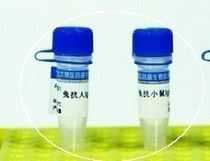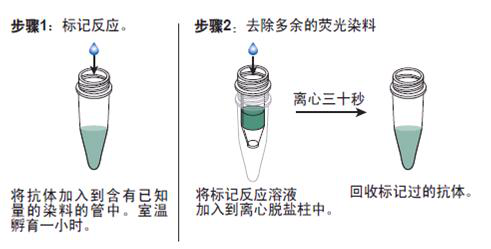
|

| 产地 | 进口、国产 |
| 品牌 | 上海莼试 |
| 保存条件 | Store at -20 °C |
| 货号 | CS10860 |
| 应用范围 | WB=1:100-500 ELISA=1:500-1000 IP=1:20-100 IHC-P=1:100-500 IHC-F=1:100-500 IF=1:50-200 |
| CAS编号 | |
| 抗体名 | Anti-phospho-Proteasome 20S beta 7(Ser214) |
| 克隆性 | |
| 靶点 | 详见说明书 |
| 适应物种 | 详见说明书 |
| 形态 | 详见说明书 |
| 宿主 | 详见说明书 |
| 亚型 | IgG |
| 标识物 | 详见说明书 |
| 浓度 | 1mg/1ml% |
| 免疫原 | KLH conjugated Synthesised phosphopeptide derived from human Proteasome 20S beta 7 around the phosphorylation site of Ser214 |
产品订购信息:
英文名称 Anti-phospho-Proteasome 20S beta 7(Ser214)
中文名称 磷酸化蛋白酶体PSMβ7抗体说明书
别 名 Proteasome 20S beta 7 (phospho S214); Proteasome 20S beta 7 (phospho Ser214); p-Proteasome 20S beta 7 (S214); p-Proteasome 20S beta 7 (Ser214); 20S Proteasome β7; Macropain chain Z; Multicatalytic endopeptidase complex chain Z; Proteasome (prosome macropain) subunit beta type 7; Proteasome beta 7 subunit; Proteasome catalytic subunit 2; Proteasome subunit alpha; Proteasome subunit beta 7; Proteasome subunit beta type-7; Proteasome subunit Z; PSB7_HUMAN; PSMB7; PUP1.


浓 度 1mg/1ml
规 格 0.2ml/200μg
抗体来源 Rabbit
克隆类型 polyclonal
交叉反应 Human, Mouse, Rat, Dog, Pig, Cow, Rabbit, Sheep
产品类型 一抗 磷酸化抗体
研究领域 细胞生物 细胞周期蛋白 细胞分化
蛋白分子量 predicted molecular weight: 25kDa
性 状 Lyophilized or Liquid
免 疫 原 KLH conjugated Synthesised phosphopeptide derived from human Proteasome 20S beta 7 around the phosphorylation site of Ser214
亚 型 IgG
纯化方法 affinity purified by Protein A
储 存 液 Preservative: 15mM Sodium Azide, Constituents: 1% BSA, 0.01M PBS, pH 7.4
磷酸化蛋白酶体PSMβ7抗体说明书 产品应用 WB=1:100-500 ELISA=1:500-1000 IP=1:20-100 IHC-P=1:100-500 IHC-F=1:100-500 IF=1:50-200
(石蜡切片需做抗原修复)
not yet tested in other applications.
optimal dilutions/concentrations should be determined by the end user.
保存条件 Store at -20 °C for one year. Avoid repeated freeze/thaw cycles. The lyophilized antibody is stable at room temperature for at least one month and for greater than a year when kept at -20°C. When reconstituted in sterile pH 7.4 0.01M PBS or diluent of antibody the antibody is stable for at least two weeks at 2-4 °C.
Important Note This product as supplied is intended for research use only, not for use in human, therapeutic or diagnostic applications.
产品介绍 The proteasome is a multicatalytic proteinase complex which is characterized by its ability to cleave peptides with Arg, Phe, Tyr, Leu, and Glu adjacent to the leaving group at neutral or slightly basic pH. The proteasome has an ATP-dependent proteolytic activity. This unit is responsible of the trypsin-like activity.The proteasome represents a large protein complex that exists inside all eukaryotes and archaea, and in some bacteria. The main function of proteasomes is to degrade unnecessary or damaged proteins by proteolysis. The most common form of the proteasome, known as the 26S Proteasome, contains one 20S Proteasome core particle structure and two 19S regulatory caps. The 20S Proteasome core is hollow and forms an enclosed cavity, where proteins are degraded, as well as openings at the two ends to allow the target protein to enter. The 20S Proteasome core particle contains many subunits, depending on the organism.
Function : The proteasome is a multicatalytic proteinase complex which is characterized by its ability to cleave peptides with Arg, Phe, Tyr, Leu, and Glu adjacent to the leaving group at neutral or slightly basic pH. The proteasome has an ATP-dependent proteolytic activity. This unit is responsible of the trypsin-like activity.
Subunit : The 26S proteasome consists of a 20S proteasome core and two 19S regulatory subunits. The 20S proteasome core is composed of 28 subunits that are arranged in four stacked rings, resulting in a barrel-shaped structure. The two end rings are each formed by seven alpha subunits, and the two central rings are each formed by seven beta subunits. The catalytic equivalent immune-specific subunit PSMB10. Interacts with -1 TAT protein.
Subcellular Location : Cytoplasm. Nucleus.
Tissue Specificity : Expressed at a low level in colonic mucosa. Up-regulated in colorectal cancer tissues.
Similarity : Belongs to the peptidase T1B family.
Database links : UniProtKB/Swiss-Prot: Q99436.1

Anti-VAMP-3/FITC 荧光素标记囊泡相关膜蛋白3抗体IgGMulti-class antibodies规格: 0.2ml
CD166/ALCAM(activated leukocyte celladhesion molecule) 活化白细胞粘附分子抗原Multi-class antibodies规格: 0.5mg
巨噬细胞来源的趋化因子抗体 Anti-CCL22/MDC 0.1ml
SPNS1 英文名称: SPNS1抗体 0.2ml
EPS15 英文名称: 胞吞调控蛋白Eps15抗体 0.2ml
Rhesus antibody Rh Phospho-HER4 (Tyr1188) 磷酸化HER4抗体 规格 0.1ml
CD166/ALCAM(activated leukocyte celladhesion molecule) 活化白细胞粘附分子抗原Multi-class antibodies规格: 0.5mg
Anti-Melamine/HRP 辣根过氧化物酶标记三聚氰胺单克隆抗体IgGMulti-class antibodies规格: 0.2ml
Anti-Mouse IgA Whole serum 兔抗小鼠IgA抗血清Multi-class antibodies规格: 1ml
白介素6抗体 Anti-IL-6 mouse、rat 0.1ml
Rabbit anti-Dog IgG whole serum 兔抗狗IgG抗血清 1ml
FZR1 英文名称: 细胞分裂周期样蛋白20抗体 0.2ml
Rhesus antibody Rh Phospho-Progesterone Receptor(Ser190) 磷酸化孕激素受体抗体 规格 0.1ml
Anti-Mouse IgA Whole serum 兔抗小鼠IgA抗血清Multi-class antibodies规格: 1ml
TLR-9/CD289(Human Toll-like receptor 9) ELISA kit 人Toll样受体9Multi-class antibodies规格: 48T
Anti-Follistatin 卵泡抑素抗体Multi-class antibodies规格: 0.2ml
Rhesus antibody Rh Mouse Anti-human IgM/APC APC标记的小鼠抗人IgM 规格 0.1ml
NON(Human nonmethylated oligonucleotide0 ELISA Kit 人非甲基化寡核苷酸 96T
SLITRK6 英文名称: 神经突触相关蛋白SLITRK6抗体 0.2ml
CSMD3 英文名称: CSMD3蛋白抗体 0.2ml
Anti-Follistatin 卵泡抑素抗体Multi-class antibodies规格: 0.2ml
Egg-YolkSaltAgarBase
EC-MUG培养基 100(g) incubation media EC-MUG培养基 100(g)
R2A琼脂 R-2A Agar 250克 饮用水中导生细菌分离培养
DNA酶甲基绿琼脂基础于弯曲杆菌的DNA酶水解试验(GB标准)incubationmediaDNA酶甲基绿琼脂基础于弯曲杆菌的DNA酶水解试验(GB标准)
O/FMedium
梭菌强化培养基250g用于梭菌的增菌培养和计数
氯化镁孔雀绿肉汤(MM,RV Rappaport-Vassiliadis Mdeium 用于沙门氏菌的选择性增菌培养(GB标准)
麦芽浸粉 Malt extract 250克 BR
改良CCDA培养基250g/瓶用于弯曲菌选择性分离,每培养基中添加07cubationmedia改良CCDA培养基250g/瓶用于弯曲菌选择性分离,每培养基中添加0711
缓冲MUG琼脂 100g 用于滤膜MUG法检测食品中大肠杆菌数(SN/T1059.2)
磷酸化蛋白酶体PSMβ7抗体说明书 尿素琼脂培养基基础 规格: 250g 用途: 用于鉴别肠道素酶试验 (GB4789.4-2010,《中华人民共和国药典》2010年版,SN0170-92和GB130...
SS琼脂培养基 规格: 250g 用途: 用于沙门氏菌和某些志贺氏菌的选择性分离培养(GB/T4789.28-2003 中4.22, GB/T4789.4-2003 和SN...
HE琼脂培养基 规格: 250g 用途: 用于肠道致病菌特别是沙门氏菌和志贺氏菌的选择性分离培养(GB 4789.4-2010和SN/T2206.1-2008)。
胆硫乳琼脂培养基(DHL) 规格: 250g 用途: 用于肠道致病菌特别是沙门氏菌和志贺氏菌的选择性分离培养。(《中华人民共和国药典》2010年版)

抗体的生物素化标记实验要点:
1. 磷酸化蛋白酶体PSMβ7抗体说明书 如在反应混合液中有叠氮钠或游离氨基存在,会抑制标记反应。因此,蛋白质在反应前要对 0.1mol/L碳酸氢钠缓冲液或0.5mol/L硼酸缓冲液充分透析;
2.所用的NHSB及待生物素化蛋白质之间的分子比按蛋白质表面的ε-氨基的密度会有所不同,选择不当则影响标记的效率,应先用几个不同的分子比来筛选最适条件;
3.用NHSB量过量也是不利的,抗原的结合位点可能因此被封闭,导致抗体失活;
4.由于抗体的氨基不易接近可能造成生物素化不足,此时可加入去污剂如 Triton x-100, Tween20等;
5.当游离ε-氨基(赖氨酸残基的氨基)存在于抗体的抗原结合位点时,或位于酶的催化位点时,生物素化会降低或损伤抗体蛋白的结合力或活性;
6.生物素还可能与不同的功能基团,如羰基、氨基、巯基、异咪唑基及*基,也可与糖基共价结合;
7.交联反应后,应充分透析,否则,残余的生物素会对生物素化抗体与亲和素的结合产生竞争作用;
8.在细胞的荧光标记实验中,中和亲和素的本底低,但由于链霉亲和素含有少量正电荷,故对某些细胞可导致高本底。
抗体的鉴定:
1)磷酸化蛋白酶体PSMβ7抗体说明书 抗体的效价鉴定:不管是用于诊断还是用于,制备抗体的目的都是要求较高效价。不同的抗原制备的抗体,要求的效价不一。鉴定效价的方法很多,包括有试管凝集反应,琼脂扩散试验,酶联免疫吸附试验等。常用的抗原所制备的抗体一般都有约成的鉴定效价的方法,以资比较。如制备抗抗体的效价,一般就采用琼脂扩散试验来鉴定。
2)抗体的特异性鉴定:抗体的特异性是指与相应抗原或近似抗原物质的识别能力。抗体的特异性高,它的识别能力就强。衡量特异性通常以交叉反应率来表示。交叉反应率可用竞争抑制试验测定。以不同浓度抗原和近似抗原分别做竞争抑制曲线,计算各自的结合率,求出各自在IC50时的浓度,并按公式计算交叉反应率。
如果所用抗原浓度IC50浓度为pg/管,而一些近似抗原物质的IC50浓度几乎是无穷大时,表示这一抗血清与其他抗原物质的交叉反应率近似为0,即该血清的特异性较好。
3)抗体亲和力:是指抗体和抗原结合的牢固程度。亲和力的高低是由抗原分子的大小,抗体分子的结合位点与抗原决定簇之间立体构型的合适度决定的。有助于维持抗原抗体复合物稳定的分子间力有氢键,疏水键,侧链相反电荷基因的库仑力,范德华力和空间斥力。亲和力常以亲和常数K表示,K的单位是L/mol。抗体亲和力的测定对抗体的筛选,确定抗体的用途,验证抗体的均一性等均有重要意义。